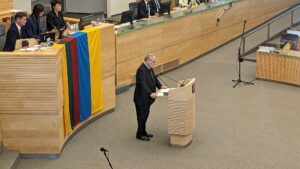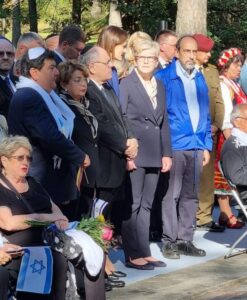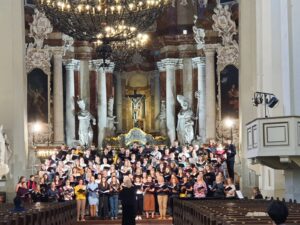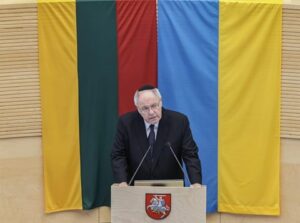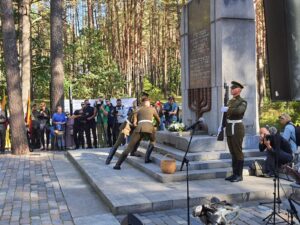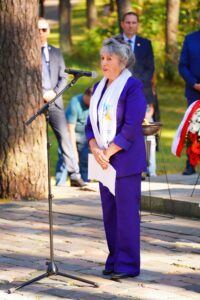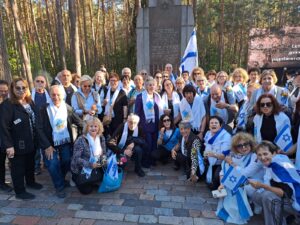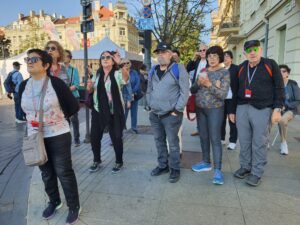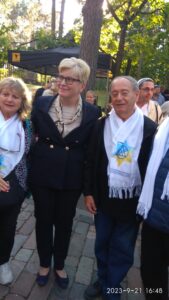March of the living 2023
March of the living to mark the 80th anniversary of the liquidation of the Vilna Ghetto and Lithuanian Jewry 2023
In preparation for the event, an extended delegation arrived in Vilna from Israel, which included 2 groups, a total of 106 participants. One group was of the families of the Association of Jews from Vilna and Vicinity in Israel and the second group was of painters from the group "The Color of Things" who came together with their family members to open an exhibition of their works in Vilna. The exhibition was held following the initiative and efforts of Mickey Kantor, who is one of the painters in this group. The title of the exhibition was "The Color of Sounds" and it took place on September 18th, on the evening of the special concert with the participation of the winners of the Nechama Lifshitz vocal competition at the City Hall in the Old Quarter of Vilna. The proceeds from the sale of the paintings were donated to the Nechama Lifshitz International Vocal Music Competition Fund.The groups went on heritage and cultural tours in Vilna and Kovna, which took place throughout the five days of the visit, and for this purpose buses were organized for tours of the artists' quarter in Uzhupis and Kovna. Hebrew-speaking guides accompanied the buses: - Irit Abramski and Regina Kopilevich in Vilna and William Tsitkauskes and Regina Kopilevich in Kovna. All the guides did a very good job. Iga Makutiana served as a consultant and administrative assistant throughout the days of the journey. On the day of the tours in Kovna, at the Ninth Fort, Yaarit Glazer told the story of the heroic escape of 64 prisoners of this hell, including her father Pinchas Krakinovski, to the woods, on Christmas Eve 1943.On September 20th, an academic panel was organized "80 years after - the Holocaust, anti-Semitism and the memory of the Holocaust" on the topic of Holocaust denial. Expert and academics in the field from Israel, Germany and Lithuania as well as public figures from Lithuania dealing with the issue attended the panel. The panel was held at the National Library of Lithuania, with the assistance of Dr. Lara Lampert, director of the Judaica Research Institute at the library and under the excellent guidance of Prof. Dina Forat of Yad Vashem, who organized the event with the help of Yaarit Glazer.To document this historic event, a photographer was hired to film and record the discussions on video.On the morning of the March of Life on September 21st, members of the delegation participated in a special meeting held in the Parliament of Lithuania, commemorating the 80th anniversary of the liquidation of the Vilna Ghetto and Lithuanian Jewry. Among the speakers were Chairman of Yad Vashem, Danny Dayan, Chairman of the Parliament as well as the Prime Minister of Lithuania, artist Samuel Bak as well as Knesset Chairman Amir Ohana whose words were transmitted by video, Member of the Lithuanian Parliament, Emmanuel Zingaris, Chairman of the Jewish Community of Lithuania, Faina Koklianski, a granddaughter of a Lithuanian Righteous Among the Nations and more.The march of the Living to Ponar was impressive. The Association's delegation was a very prominent group in its appearance with Israeli flags, and white scarves bearing the Association's logo prepared and brought from Israel and which were later distributed to the union's friends and the Lithuanian Jews who participated in the event. The group was led by a 3 m wide banner, which carried the Association's motto - "Perpetuating the memory, instilling the legacy" in Hebrew and English.On the last evening, the participants were invited by Mr. Zilvinas, the director of the Jewish library, to a meeting for a summary conversation. All the participants expressed interest, excitement and a lot of satisfaction from all the components of the visit.
Head of Yad Vashem Slams Lithuania for 'Glorifying' Antisemitic War Criminals, Ofer Aderet, 21/9/2023
In an address to Lithuania's parliament, Dani Dayan says country 'must acknowledge that many Lithuanian Jews massacred in the Holocaust died at the hands of their co-nationals' urging 'zero-tolerance towards war criminals'
Yad Vashem chairman Dani Dayan called on Lithuania to stop glorifying war criminals who were involved in the murder of Jews during the Holocaust, on the 80th anniversary of the liquidation of the Vilna Ghetto on Thursday.
Dayan's address at a special session of the Lithuanian parliament condemned the role of Lithuanians in the murder of Jews, and came out against continuous glorification of these individuals.
"Hundreds of thousands of Lithuanian Jews were murdered in this country by the German Nazis and their Lithuanian collaborators," Dayan said. "Almost the entire Jewish community of Lithuania became extinct... [That they were] annihilated so cruelly and systematically during the Holocaust – and to a significant extent by the local population – is characteristically distinct to Lithuania."
"Lithuania must consistently acknowledge that many of the Lithuanian Jews massacred in the Holocaust died at the hands of their Lithuanian co-nationals and that Lithuanians also took part in the extermination of Jews in neighboring countries," he added. "Such recognition is obviously owed to the Jewish victims, but also to the present and future generations of Lithuanians."
Dayan emphasized that it is not enough for the state to recognize these atrocities, but they must be recognized by all Lithuanians as well. His address follows a series of controversial statements by Lithuanian leaders and politicians in recent years, who minimized and even denied the role of Lithuanians in the Holocaust.
According to Dayan, Lithuania should "show zero-tolerance towards antisemitism" and toward "the glorification of war criminals associated with the massacre of Jews." He also mentioned the names of three Lithuanian national heroes who were involved in the murder of Jews during the Holocaust: Jonas Noreika, Kazys Škirpa and Juozas Krikštaponi.
By mentioning these figures, Dayan invoked a widespread phenomenon in which Lithuanians who fought against the communists for Lithuania's independence but also participated in the persecution and murder of Jews during the Holocaust are perceived today as heroes and gain public and state respect. Streets are named after them, and statues are built in their memory.
In his address, Dayan said "an antisemite, especially a murderer, cannot be considered…a good person, let alone a hero," adding that Lithuania must refrain from "attributing public honor to such butchers."
"Such names as Noreika, Škirpa, and Krikštaponi do not add to the honor of your nation, nor its adherence to international norms of appropriate national remembrance. Lithuanian history during the Holocaust indeed contained admirable rescuers. I myself, together with the prime minister, bestowed the title of Righteous Among the Nations on several of those heroes and heroines… But Lithuanian history…also included vile perpetrators. And of course, many bystanders. All of them must be remembered accurately, proportionally and in context."
About 220,000 Jews lived in Lithuania under the Nazi occupation. Less than 4 percent of them survived the Holocaust. Almost all of them were shot to death not far from their houses by their neighbors. Research carried out in recent years by the Nazi hunter Dr. Efraim Zuroff and the Lithuanian writer Ruta Vanagaite shows that at least 20,000 people participated in the mass murder of Jews in Lithuania in various capacities, from encouragement and assistance to the actual shooting.
"Many of the shooters were uneducated or even illiterate, but there were also those who belonged to different strata of Lithuanian society: the clergy, the intelligentsia and the liberal professions," said Zuroff in an interview with Haaretz's Hebrew edition in 2018. "Every Lithuanian can locate a mass grave in a distance no longer than half an hour away from his house," he added.
Dayan is scheduled to participate in several Holocaust commemoration events in Lithuania, including the March of Life and a memorial ceremony at Lithuania's Ponar Woods, where Jews were murdered.
Remembering Lithuania's Ponary massacre
Marking 80 years since the liquidation of the Vilnius Ghetto: a march from the Jewish Ghetto in Vilnius to the mass grave at Ponary where most of Lithuanian Jews were murdered between 1941-1943, Hod Bass|09.21.23
Marking the National Memorial Day for the Genocide of Lithuanian Jews, the Prime Minister of Lithuania, Ingrida Šimonytė along with other senior Lithuanian Government officials and the International Commission for the investigation of the Nazis crimes in Lithuania, members and leaders of the Lithuanian Jewish community, and Holocaust education and commemoration organization embark on the International March of the Living, in a symbolic march from the site of the Jewish Ghetto in Vilnius, to the mass grave on the Paneriai (formerly Ponary) suburb of the city.
The Ponary massacre, was the mass murder of up to 100,000 people, mostly Jews, Poles, and Russians, by Nazis and their Lithuanian collaborators. The murders took place between July 1941 and August 1944 near the railway station at Ponary, a suburb of today's Vilnius. Around 70,000 Jews were murdered at Ponary, along with up to 20,000 Poles, and 8,000 Soviet POWs, most of them from nearby Vilnius, and its newly formed Vilna Ghetto.gallery
“The International March of the Living holds marches throughout Europe throughout the year, on national days such as Holocaust Remembrance Day, often marking the day on which Jews were carried away to the extermination camps, or to the woods to be murdered in mass graves. The Ponary Massacre was one of the cruelest mass killings of those dark days, and our annual march serves as a memorial to the Jews who once lived there and had their lives brutally cut short. It also serves as a reminder to us all that antisemitism and hatred still persist, and we must always boldly proclaim, Never Means Never," said Michel Gourary, Director of the European March of the Living," a statement from the organizers read.
"What happened is not just a tragedy of the Jewish people, it is a tragedy of all the peoples who lived then and live now in Lithuania – it is a tragedy of the whole world. However, such catastrophes can happen again – outbreaks of violence and incitement to hatred have not gone away," Lithuania Prime Minister Ingrida Šimonytė said in 2022.
The Nazis began the Aktion (German codename for actions leading to the mass killing) in July of 1941. Before the end of 1941, the bulk of the Jews of the Vilnius ghettos were wiped out, estimated at around 50,000 Jews. On October 21, Ghetto II was liquidated and thousands were murdered in Ghetto I before the end of October.
"Don't let them take you! Escape into the streets!" there was chaos; women lay down in the road, the elderly stood petrified and the youngsters fled.
In Kazimierz Sakowicz, Ponary Diary, 1941-1943: A Bystander’s Account of a Mass Murder, he chronicled most of the Ponary massacre killings and depicts the cruelty of the Nazis and their around 80 Lithuanian collaborators: "11th July (1941). Lovely weather. It's hot out; there are white clouds and a gentle breeze. Shooting can be heard from the forest. Presumably from training. The shooting started at 4 pm. Then I was informed that many Jews were transported to the forest via the road to Grodno and were then shot. This was the first day of executions. A depressing feeling. The shooting stopped at about eight in the evening. For the Germans, 300 Jews are 300 enemies of humanity. For the Lithuanians 300 Jews are 300 pairs of shoes, trousers and clothes."
On September 15, 1941, the Ghetto Police announced that anyone in the ghetto who did not have a work certificate in Ghetto I should move to Ghetto II that very evening. About 3,000 people presented themselves at the gate. Only 600 were resettled to Ghetto II. The others were taken to the Lukiszki prison and to Ponary and were murdered. Even following this Aktion, the elderly and sick were resettled from Ghetto I to Ghetto II and simultaneously, work certificate holders were resettled from Ghetto II to Ghetto I.
Yom Kippur Aktion
On Yom Kippur, October 1, 1941, Aktionen took place in both ghettos. At noon, when the synagogues were full, Germans and Lithuanians under the command of the SS the commander, Schweinberger entered Ghetto II, rounded up approximately 1,700 Jews and deported them to Lukiszki. In the afternoon Schweinberger turned to the Judenrat of Ghetto I and demanded 1,000 Jews by 19:30 that evening.
When the Jews were not delivered to them, the Germans and Lithuanians entered the ghetto and began taking people from their homes. Work certificate holders and their families presented themselves at the gate with a sense that they were protected from deportation. The majority of those who did not have work certificates hid. 2,200 people presented themselves at the gate and were taken to Lukiszki, among them work certificate holders. According to various sources up to 800 people were freed from Lukiszki by the German units and institutions that employed them. There were also Jews who were freed in exchange for bribes paid to the Germans and Lithuanians. The Yom Kippur Aktion increased the fear and uncertainty in the ghetto. It became clear that the "golden" work certificate did not buy safety for its holder.
Liquidation of Ghetto II
In October 1941 three Aktionen were carried out in Ghetto II. During the first Aktion the Jews were told that they were being taken to a third ghetto where there was a shortage of workers. When people saw that they were being taken in the direction of Lukiszki they lay down in the street and refused to move.
Jews recorded acts that led to the mass killings: "On the way to the prison Moshe Frumkin, a youth of 18, called to the people that were being transported with him, "Don't let them take you! Escape into the streets!" there was chaos; women lay down in the road, the elderly stood petrified and the youngsters fled. Schweinberger gave the order to shoot. Dozens of people were killed and those who remained alive were forced to carry them. Even so, many escaped." A. Sutzkever, Vilna Ghetto, p. 50
The second Aktion took place on Shmini Atseret and Simchat Torah (the last two days of the holiday of Succot). Despite the previous Aktion and the fact that the elderly and sick had been transferred from Ghetto I to Ghetto II, there was still no sense among the Jews that the end of the ghetto was near. People still left the ghetto to go to work every day. According to Jewish sources about 3,000 people were taken from the ghetto to Ponary in this Aktion. In the third Aktion, on the 21st of October, about 2,500 Jews were deported to Ponary and murdered. Thus Ghetto II was liquidated.
Lithuanian Jewry consisted of approximately 200,000 Jews before the Holocaust, with 70,000 living in the capital city of Vilnius, where the main ghetto was built. The Nazis nearly obliterated the Jewish community in Lithuania in the Summer and Autumn of 1941 in what is called “Holocaust by Bullets,” when Nazis shot the Jews of Eastern Europe and buried them in mass graves. Over 200 Jewish communities were obliterated in Lithuania alone. Ponary marks one of the most prominent symbols of the Holocaust, for Eastern European Jews and in general.

